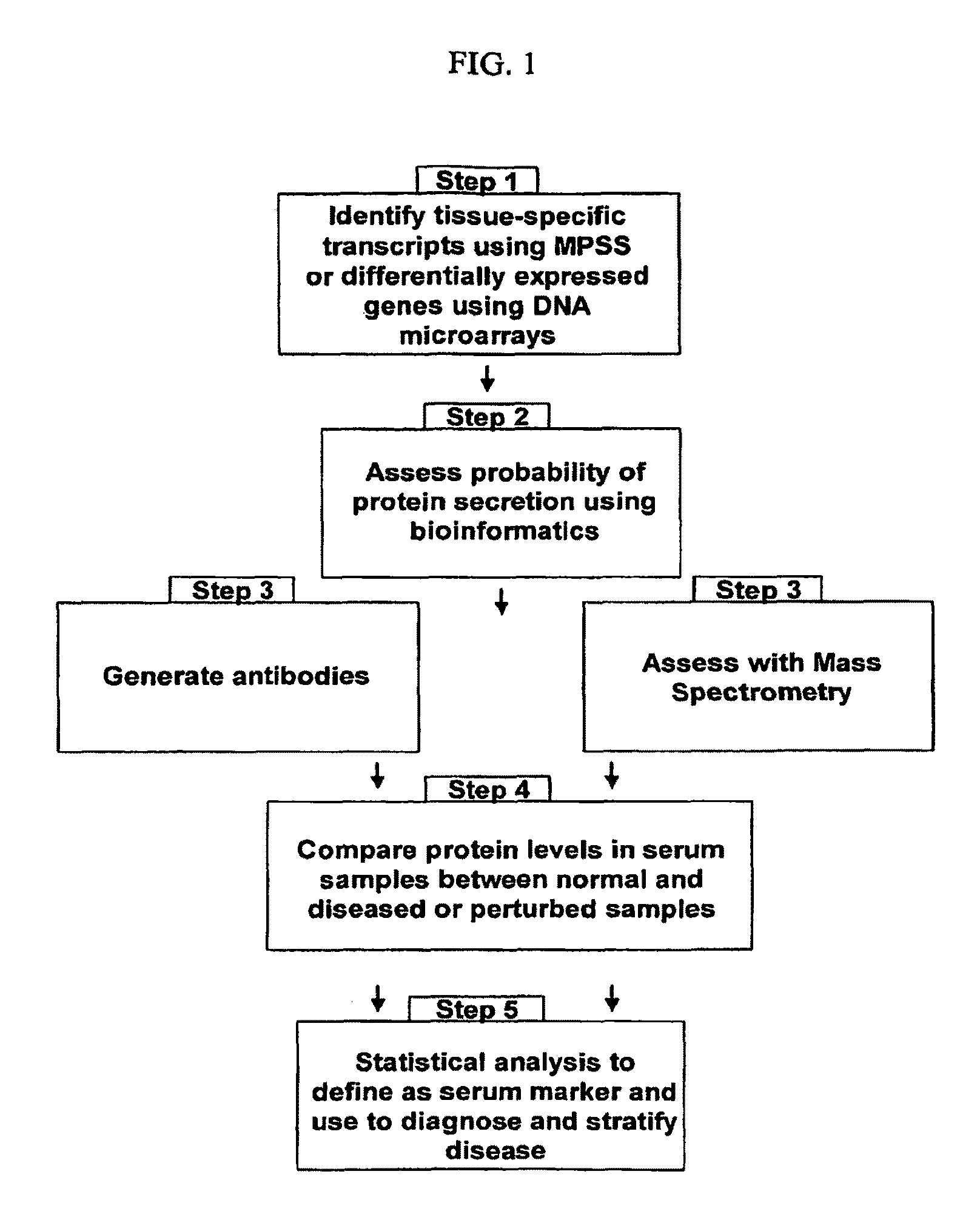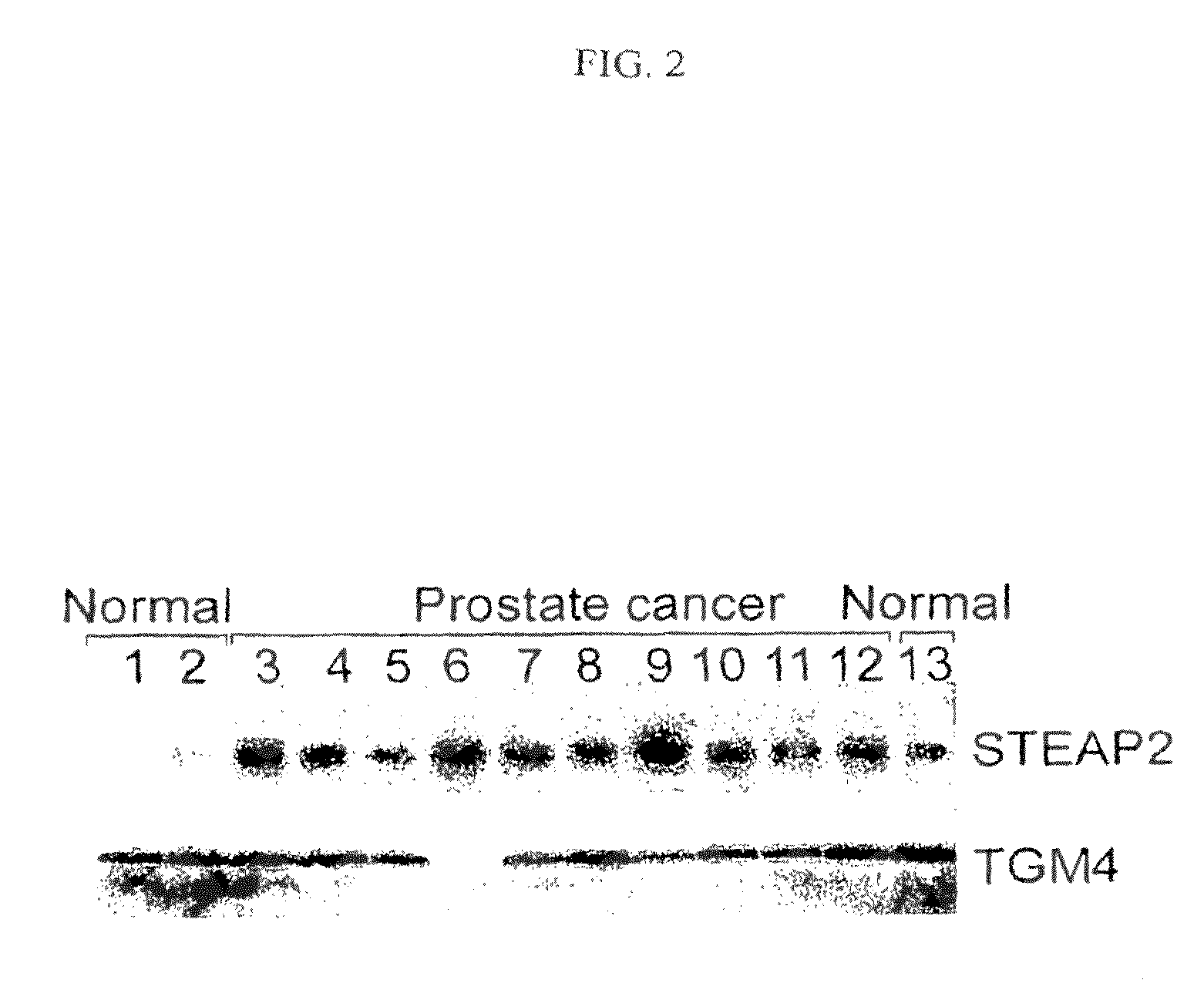Organ-specific proteins and methods of their use
a technology of organ-specific proteins and methods, applied in the field of organ-specific proteins and polynucleotides, can solve the problems of reducing patient survival, preventing early detection and diagnosis, and current diagnostic assays that may not detect disease,
- Summary
- Abstract
- Description
- Claims
- Application Information
AI Technical Summary
Benefits of technology
Problems solved by technology
Method used
Image
Examples
example 1
Identification of Organ-Specific Proteins by Analysis of MPSS Data
[0696]This example shows the identification of organ-specific protein sets from 32 normal, healthy organs.
1. Normalized MPSS Dataset
[0697]The normalized MPSS data used in this study was previously described (Jongeneel, et al., Genome (2005), 15:1007-1014) but re-annotated by Solexa (Hayward, Calif., USA) to the new UniGene database. The data contained a total of 391,669 MPSS sequence tags, their gene annotation, their expression levels in 32 different tissues as specified by their transcription per million (tpm) and the associated standard deviation (SD), and information on the sequence tags such as significance, selected step, class, and global replication. This dataset was used to identify organ-specific proteins as described below.
Identification of Organ-Specific MPSS Tags
[0698]Assume the expression (in tpm) and the associated SD of a MPSS sequence tag in the 32 tissues were {(Xi,σi)}, where i=1, 2, . . . , 32 repr...
example 2
Identification of Organ-Specific Proteins in Human Serum Using Mass Spectrometry
[0723]This experiment demonstrates the process of identifying organ-specific proteins in a normal sample of blood serum from a healthy, human volunteer. For normal control serum, venous blood samples were drawn from a fasted, human volunteer. Samples were collected with minimal stasis in evacuated serum separator tubes. After at least 30 min, but within 2 hours, the tubes were centrifuged at 23° C. for 15 minutes at 1,200 g and serum was stored in plastic vials at −80° C. To reduce sample complexity, plasma was passed over a column containing antibodies to the most abundant proteins. In this example, an affinity column was used to remove albumin, IgG, IgA, anti-trypsin, transferrin, and haptoglobin; however, affinity columns with an expanded repertoire could also be used. Since most proteins found on the cell surface or secreted from cells are glycoproteins, and can be isolated via the glycopeptide captu...
example 3
Verification and Quantification of Serum Proteins Using Enzyme-Linked Immunosorbant Assay (ELISA)
[0730]Blood serum tests to detect and monitor proteins were developed using an enzyme-linked immunosorbent assay (ELISA). The assay system utilized two antibodies directed against different antigenic regions of the candidate protein. A monoclonal antibody directed against a distinct antigenic determinant on the intact candidate protein was used for solid phase immobilization on the microtiter wells. A detection antibody conjugated to horseradish peroxidase (HRP) or fluorescence tag recognized the candidate protein within different region of the same protein. The candidate protein reacted simultaneously with the two antibodies, resulting in the protein being sandwiched between the solid phase and detection antibody. The detection antibody was visualized by colorimetric fluorescence analysis.
[0731]In the case of peptides detected in blood, the specific peptide was further enriched from pep...
PUM
 Login to View More
Login to View More Abstract
Description
Claims
Application Information
 Login to View More
Login to View More - R&D
- Intellectual Property
- Life Sciences
- Materials
- Tech Scout
- Unparalleled Data Quality
- Higher Quality Content
- 60% Fewer Hallucinations
Browse by: Latest US Patents, China's latest patents, Technical Efficacy Thesaurus, Application Domain, Technology Topic, Popular Technical Reports.
© 2025 PatSnap. All rights reserved.Legal|Privacy policy|Modern Slavery Act Transparency Statement|Sitemap|About US| Contact US: help@patsnap.com



